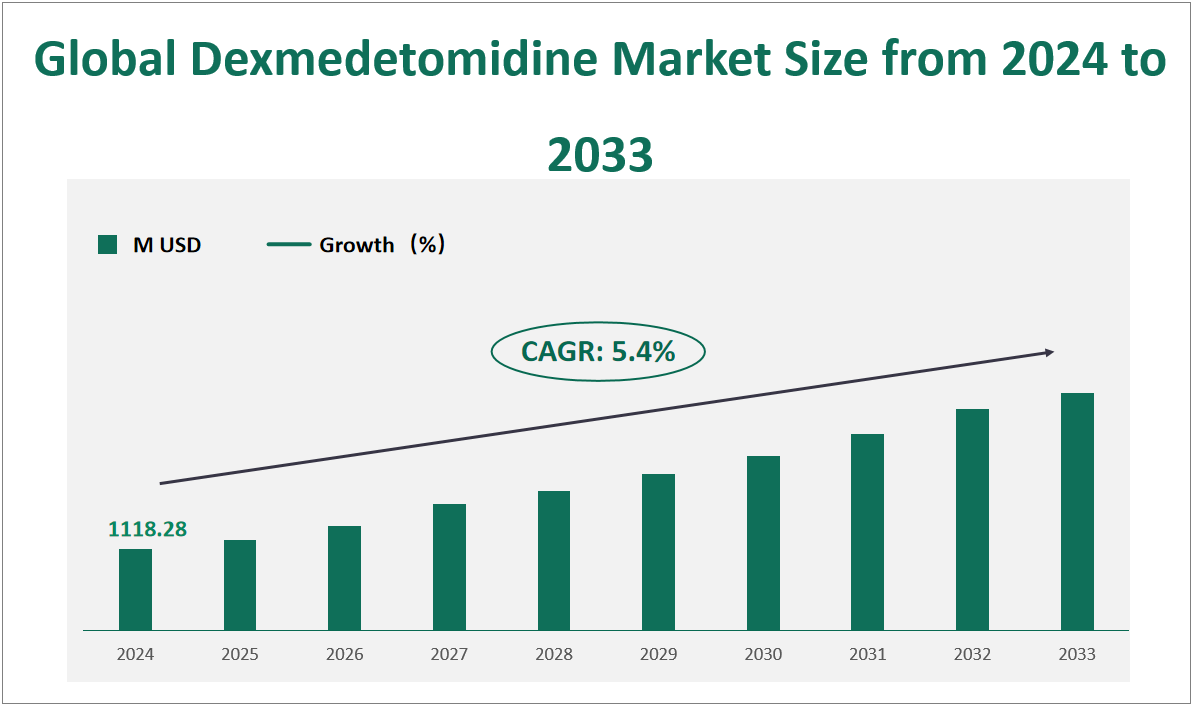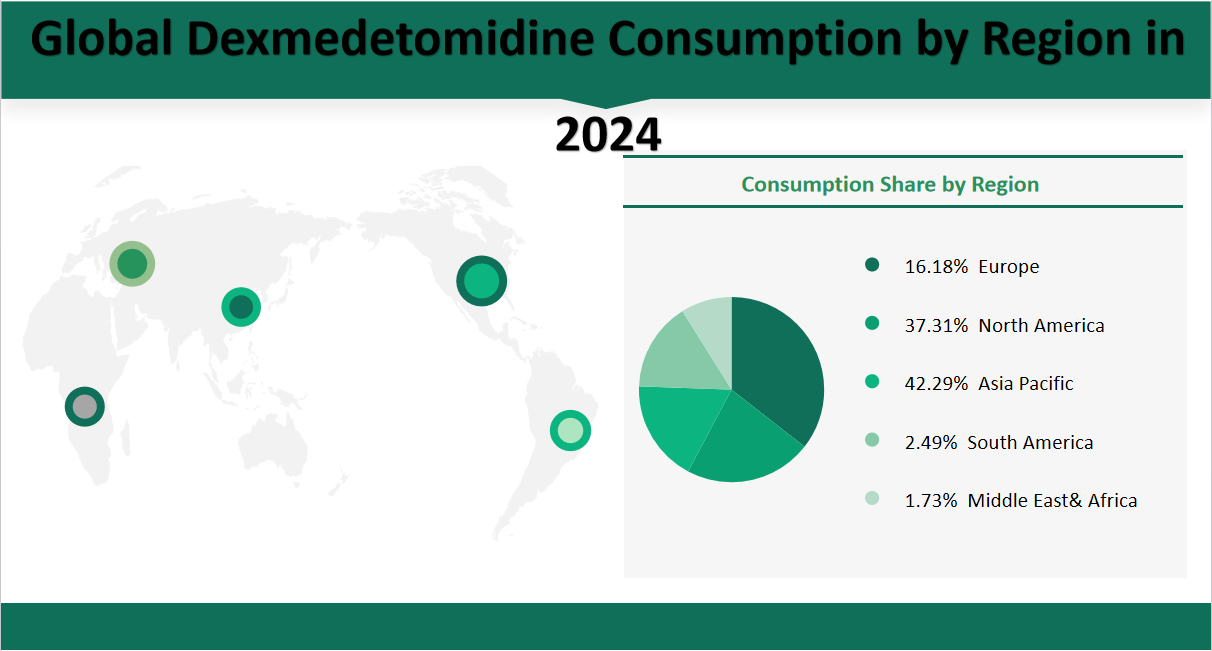1 Global Dexmedetomidine Market Outlook
The global Dexmedetomidine market is projected to exhibit substantial growth in the coming years, with a CAGR of 5.4% from 2024 to 2033, reaching a total market size of $1118.28 million USD in 2024. Dexmedetomidine is a selective alpha-2 adrenergic receptor agonist primarily used for sedation in intensive care units and during surgical procedures. It is particularly valued for its ability to provide sedation without causing significant respiratory depression, making it a preferred choice for patients requiring mechanical ventilation or undergoing anesthesia. The market’s growth is driven by increasing demand from the healthcare sector, especially in the management of critical care patients and procedural sedation.
Figure Global Dexmedetomidine Market Size and Growth Rate (2024-2033)

2 Dexmedetomidine Market Growth Drivers and Constraints
The growth of the global Dexmedetomidine market is influenced by several key factors. On the positive side, the increasing prevalence of chronic diseases and the growing demand for effective sedation and anesthesia solutions are major drivers. The COVID-19 pandemic has also highlighted the importance of sedatives in critical care, further boosting the market. Additionally, advancements in medical technology and the development of new formulations of Dexmedetomidine, such as sublingual films and oral gels, are expanding its applications and market reach.
However, the market also faces several challenges. Regulatory hurdles and stringent approval processes for new drugs can slow down the introduction of innovative products. The high cost of research and development, coupled with the need for significant investment in clinical trials, can be a barrier for smaller companies. Moreover, the side effects associated with Dexmedetomidine, such as bradycardia and hypotension, may limit its widespread use. The economic impact of the COVID-19 pandemic has also affected the market, with disruptions in supply chains and reduced healthcare spending in some regions.
In conclusion, the global Dexmedetomidine market is poised for steady growth, driven by increasing demand and technological advancements. However, regulatory and economic challenges must be navigated to ensure sustainable development. As companies continue to innovate and expand their portfolios, the market is expected to evolve, offering new opportunities for growth and development.
3 Dexmedetomidine Market Innovations and M&A Activities
The Dexmedetomidine market has seen significant technological innovation and corporate activity in recent years. Companies are continuously investing in R&D to develop new formulations and delivery methods. For example, BioXcel Therapeutics has received approval for a sublingual thin-film formulation of Dexmedetomidine, aimed at treating acute agitation in various neuropsychiatric conditions. This innovation not only expands the therapeutic applications of Dexmedetomidine but also enhances patient convenience.
Corporate mergers and acquisitions have also played a crucial role in shaping the market landscape. In 2020, Mylan merged with Pfizer’s off-patent medicine division, Upjohn, to form Viatris. This merger has significantly expanded the combined company’s portfolio, providing a broader range of products and enhancing its market position. Additionally, several generic drug manufacturers have received approval for Dexmedetomidine hydrochloride injections, increasing competition and driving market growth.
4 Global Dexmedetomidine Market Analysis by Type
In 2024, the global Dexmedetomidine market is projected to reach a total value of 1,118.28 million USD across all doses. The market is segmented by doses, with the 0.004 mg/mL dose accounting for 37.12% of the total value, equivalent to 415.07 million USD. The 0.1 mg/mL dose holds the largest market share at 55.44%, contributing 619.92 million USD to the total value. The 0.5 mg/mL dose represents 4.21% of the market, valued at 47.08 million USD, while other doses account for 3.24% or 36.21 million USD. This distribution highlights the dominance of the 0.1 mg/mL dose in the market, driven by its widespread use in various medical procedures and sedation applications.
Table Global Dexmedetomidine Market Size and Share by Type in 2024
Type | Market Size in 2024 (M USD) | Market Share in 2024 (%) |
|---|---|---|
0.004mg / mL | 415.07 | 37.12% |
0.1 mg / mL | 619.92 | 55.44% |
0.5 mg / mL | 47.08 | 4.21% |
Others | 36.21 | 3.24% |
5 Global Dexmedetomidine Market Analysis by Application
In 2024, the global Dexmedetomidine market is projected to consume a total of 111,079 kilograms across all applications. The largest share of this consumption is attributed to Intensive Care Unit (ICU) Sedation, which is expected to account for 73.12% of the total, equivalent to 81,221 kilograms. This significant proportion underscores the critical role of Dexmedetomidine in managing sedation for patients in intensive care settings. Procedural Sedation follows with a consumption of 22,627 kilograms, representing 20.37% of the total market. The remaining 6.51%, or 7,231 kilograms, is attributed to Other applications. This breakdown highlights the continued dominance of ICU sedation in driving the demand for Dexmedetomidine, while procedural sedation also maintains a substantial market presence.
Table Global Dexmedetomidine Consumption and Share by Application in 2024
Application | Consumption in 2024 (Kgs) | Consumption Share in 2024 (%) |
|---|---|---|
Intensive Care Unit Sedation | 81221 | 73.12% |
Procedural Sedation | 22627 | 20.37% |
Others | 7231 | 6.51% |
6 Global Dexmedetomidine Market Analysis by Region
In 2024, the global Dexmedetomidine market is forecasted to consume a total of 111079 kilograms across all regions. Among these, North America is expected to account for 41446 kilograms, representing 37.31% of the global consumption. Europe will consume 17973 kilograms, contributing 16.18% to the total. Asia-Pacific, the largest regional market, is projected to consume 46973 kilograms, accounting for 42.29% of the global total. Middle East and Africa will have a consumption of 1923 kilograms, representing 1.73%, while South America is expected to consume 2764 kilograms, or 2.49% of the global total. This regional breakdown highlights the significant contribution of Asia-Pacific to the global market, driven by its growing healthcare needs and expanding pharmaceutical industry, while North America and Europe also maintain substantial shares.
Figure Global Dexmedetomidine Consumption by Region in 2024

7 Top 3 Companies of Global Dexmedetomidine Market
7.1 Pfizer Inc.
Company Introduction and Business Overview:
Pfizer Inc. is an American multinational pharmaceutical corporation, recognized as one of the world’s largest pharmaceutical companies. Established in 1843 and headquartered in Manhattan, New York, Pfizer develops and produces medicines and vaccines for a wide range of medical disciplines, including immunology, oncology, cardiology, endocrinology, and neurology. The company’s extensive portfolio includes Precedex (Dexmedetomidine), a selective alpha-2 adrenergic agonist used for sedation in intensive care units and during surgical procedures.
Products Offered:
Pfizer’s Dexmedetomidine product, Precedex, is available in various concentrations and formulations, including 200 mcg/2 mL vials and larger single-dose bottles. Precedex is indicated for sedation of intubated and mechanically ventilated patients in intensive care settings, as well as for procedural sedation in non-intubated patients. The product is known for its ability to provide effective sedation without significant respiratory depression, making it a preferred choice in critical care scenarios.
Sales Revenue in the Latest Year:
Pfizer’s Dexmedetomidine sales reached 16,976 kilograms, generating a revenue of 245.32 million USD. The company’s gross margin for this product was 86.74%, reflecting its strong market position and efficient production processes. Pfizer’s continuous investment in research and development, coupled with its global sales network, has enabled it to maintain a competitive edge in the Dexmedetomidine market.
7.2 Yangtze River Pharmaceutical Group
Company Introduction and Business Overview:
Yangtze River Pharmaceutical Group, founded in 1971, is a leading Chinese pharmaceutical company headquartered in Taizhou City, Jiangsu Province. The company is recognized as one of the first batch of innovative enterprises in China, with a strong focus on the development and production of high-quality pharmaceutical products. Yangtze River Pharmaceutical Group has over 16,000 employees and operates primarily in China, with a significant presence in the domestic market.
Products Offered:
The company’s Dexmedetomidine product, marketed under the trade name Youbituo, is a hydrochloride injection used for sedation during tracheal intubation and mechanical ventilation in surgical patients. It is also used for sedation in intensive care settings, with continuous infusion not exceeding 24 hours. Youbituo is available in various concentrations, catering to different medical needs and patient requirements.
Sales Revenue in the Latest Year:
Yangtze River Pharmaceutical Group achieved sales of 18278 kilograms of Dexmedetomidine, generating a revenue of 163.16 million USD. The company’s gross margin for this product was 85.63%, highlighting its efficiency in production and strong market performance. Yangtze River Pharmaceutical Group’s focus on innovation and quality has enabled it to capture a significant share of the domestic market and expand its presence in the global Dexmedetomidine sector.
7.3 Orion Pharma
Company Introduction and Business Overview:
Orion Pharma, a subsidiary of Orion Corporation, is a prominent pharmaceutical company based in Finland. Established in 1996, Orion Pharma operates primarily in Europe and is listed on the Nasdaq OMX Helsinki stock exchange. The company specializes in the development and production of prescription-only medicines, with a focus on respiratory, central nervous system, oncology, and critical care therapies.
Products Offered:
Orion Pharma’s Dexmedetomidine product, Dexdor, is indicated for sedation in adult intensive care unit patients and non-intubated patients undergoing diagnostic or surgical procedures. Dexdor is available in various concentrations and formulations, designed to meet the specific needs of healthcare providers and patients. The product is known for its safety and efficacy in providing sedation without significant side effects.
Sales Revenue in the Latest Year:
Orion Pharma’s Dexmedetomidine sales reached 5,465 kilograms, generating a revenue of 70.16 million USD. The company’s gross margin for this product was 83.42%, reflecting its strong market position and efficient production processes. Orion Pharma’s commitment to innovation and quality has enabled it to maintain a competitive edge in the European market and expand its presence globally.

